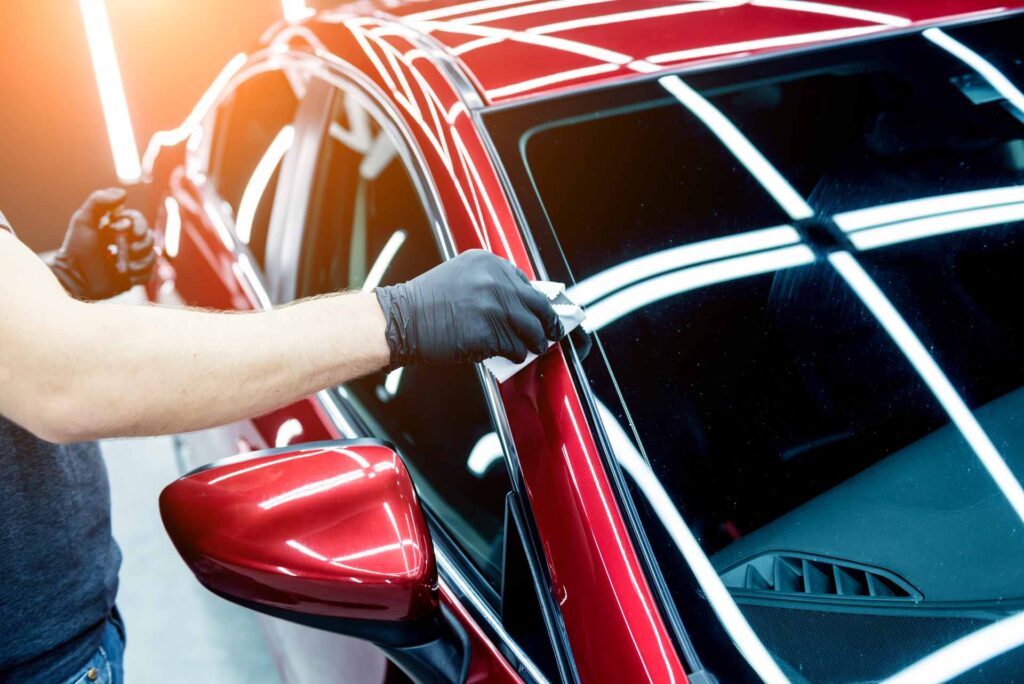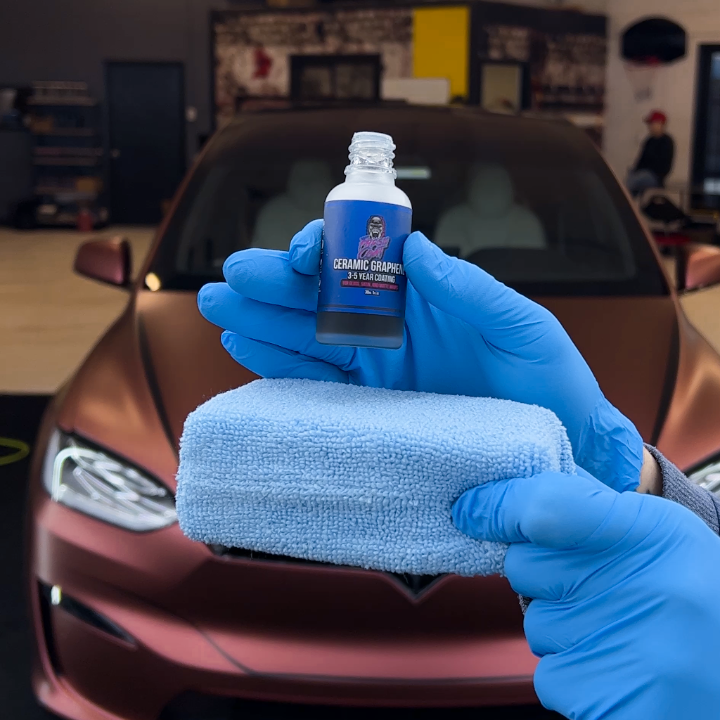The Ecological Benefits of Using Ceramic Coating on Your Car
Wiki Article
Understanding the Science Behind Ceramic Coating for Boosted Vehicle Longevity
The scientific research of ceramic covering is reinventing car maintenance by providing a powerful shield against harsh environmental factors. As we discover the detailed structure and application procedure of ceramic layers, we discover the tricks behind their exceptional defense and longevity (ceramic coating). How does this compare to typical techniques, and what ramifications does it have for car maintenance in the long term?
Composition of Ceramic Coatings
Ceramic layers are mainly composed of silicon dioxide (SiO2), which is stemmed from all-natural materials like quartz and sand. This compound forms the backbone of the finishing, providing its particular solidity and resistance to ecological components. Along with SiO2, ceramic layers usually include titanium dioxide (TiO2) for boosted UV protection and raised resistance to toxic wastes. These nanocomposite materials create a durable, chemical bond with the car's surface area, offering a long-lasting safety layer.The solution of ceramic finishes is a careful process where the focus of SiO2 can substantially affect the layer's performance. Higher SiO2 web content commonly results in higher durability and firmness, adding to the finishing's ability to stand up to scratches and chemical etching. Nevertheless, the balance of elements is important; way too much SiO2 can make the finishing fragile, while insufficient can compromise its safety residential or commercial properties.
Makers may additionally incorporate added materials, such as polysilazane, to boost versatility and simplicity of application. These ingredients improve the finish's hydrophobic residential properties, making certain water and impurities grain off the surface effortlessly. This crafted composition underscores the efficiency of ceramic finishings in guarding a vehicle's exterior against a selection of adverse conditions.
Application Refine Discussed
Using a ceramic layer to a vehicle includes numerous crucial actions, each necessary to ensuring optimal attachment and efficiency of the protective layer - ceramic coating. The process begins with a detailed clean and purification of the automobile's surface area to get rid of dirt, grime, and previous waxes or sealers. This action is critical as any kind of impurities left on the surface can hinder the finishing's capability to bond effectivelyFollowing the preliminary cleansing, the next step entails brightening the lorry to remove any kind of blemishes, such as swirl marks or scratches. Sprucing up makes sure a smooth surface, which is crucial for the layer to stick correctly and give an uniform surface. After brightening, a surface area preparation spray is utilized to eliminate any type of continuing to be deposits and ensure that the surface is completely clean.

Safety Benefits
Usually hailed for its phenomenal protective top qualities, a ceramic covering uses countless benefits that substantially boost automobile sturdiness. At its core, ceramic covering creates a hard, semi-permanent obstacle over a car's outside, which works as a guard against numerous environmental threats. This innovative layer of defense successfully protects against UV rays, oxidation, and fading, maintaining the automobile's original paint and shine. It minimizes the threats posed by dangerous contaminants such as bird droppings, tree sap, and roadway gunk, which, if left without treatment, can bring about irreversible damage.Moreover, ceramic finishes show hydrophobic buildings, implying they repel water and help with a self-cleaning impact. This quality decreases the adherence of dust and mud, streamlining upkeep and cleansing processes. The finishing's resistance to chemical etching even more guarantees that the lorry's surface area stays unblemished despite exposure to harsh cleaning representatives and contaminants.
Along with these safety advantages, the ceramic finishing improves a vehicle's visual allure by producing a shiny coating that emphasizes shade deepness and clearness. This not just maintains the car's visual allure however also adds to its long-term worth by preserving the stability of its outside in time.
Contrasting to Conventional Techniques
Unlike conventional methods of car security, such as waxing or sealants, ceramic article coverings offer a more long-lasting and resilient service. Where waxes and sealers normally offer a short-lived layer of protection, frequently requiring reapplication every few months, ceramic layers develop a semi-permanent bond with the car's paint. This bond develops a protective layer that is resistant to ecological impurities, UV damage, and small abrasions.Conventional waxes are largely composed of all-natural components like carnauba wax, giving a shiny surface but lacking the durable safety qualities of ceramic coatings. Sealers, while artificial and offering somewhat better resilience than waxes, still fall short in comparison to the resilience and chemical resistance of ceramic finishes. The advanced innovation of ceramic finishings includes nanotechnology, which enables them to fill up in microscopic imperfections in the paint surface, leading to a smoother and a lot more hydrophobic finish.
In terms of application, ceramic finishings need an even more precise process, often demanding expert installation to ensure optimum efficiency. This contrasts with the fairly uncomplicated application of sealants and waxes, which can be applied at home. The exceptional security and aesthetic improvement offered by ceramic finishes justify the financial investment for those looking for long-term vehicle conservation.
Longevity and Maintenance
How does the durability of ceramic coatings equate into ease of maintenance for vehicle proprietors? The innovative formula of ceramic page finishings provides a durable protective layer on the lorry's surface, which substantially prolongs the lifespan of the cars and truck's outside coating.In addition, the hydrophobic nature of ceramic layers makes it possible for water and other fluids to grain up and roll off the surface, lugging dust and particles with them. While the covering itself is lasting, it is not completely maintenance-free. Thus, ceramic coverings supply Bonuses a useful equilibrium between lasting toughness and simplified upkeep for automobile treatment.
Conclusion
Ceramic layers, with their innovative chemical composition of silicon dioxide and titanium dioxide, offer an awesome obstacle against environmental damage, dramatically enhancing vehicle durability. The hydrophobic buildings promote self-cleaning, decreasing upkeep initiatives and preserving aesthetic allure. When contrasted to conventional techniques, ceramic finishings use exceptional security against UV rays, oxidation, and chemical etching. This modern technology prolongs the life expectancy of vehicle outsides, making it an ingenious remedy for lasting conservation and marginal upkeep.
The formulation of ceramic coatings is a precise process where the focus of SiO2 can dramatically affect the covering's performance.Applying a ceramic layer to a lorry involves several vital actions, each vital to ensuring ideal attachment and performance of the safety layer.Usually hailed for its exceptional safety top qualities, a ceramic coating provides many advantages that dramatically enhance automobile durability. The advanced formula of ceramic coverings offers a robust protective layer on the lorry's surface area, which significantly extends the life-span of the cars and truck's exterior surface.Ceramic layers, with their sophisticated chemical composition of silicon dioxide and titanium dioxide, give an awesome barrier versus environmental damage, significantly boosting car sturdiness.
Report this wiki page